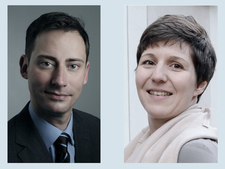-
Topics
subnavigation
Topics
Electromagnetic fields
- What are electromagnetic fields?
- Static and low-frequency fields
- Radiation protection relating to the expansion of the national grid
- High-frequency fields
- Radiation protection in mobile communication
Optical radiation
Ionising radiation
- What is ionising radiation?
- Radioactivity in the environment
- Applications in medicine
- Applications in daily life and in technology
- Effects
- What are the effects of radiation?
- Effects of selected radioactive materials
- Consequences of a radiation accident
- Cancer and leukaemia
- Genetic radiation effects
- Individual radiosensitivity
- Epidemiology of radiation-induced diseases
- Ionising radiation: positive effects?
- Risk estimation and assessment
- Radiation protection
- Nuclear accident management
- Service offers
-
The BfS
subnavigation
The BfS
- About us
- Science and research
- Laws and regulations
- BfS Topics in the Bundestag
- Links
Incurable form of leukaemia genetically decoded
BfS-funded project provides crucial evidence for cancer research
- Little is known about the formation of childhood leukaemia, compared to other cancer types.
- Even low doses of ionising and non-ionising radiation are suspected of being able to cause leukaemia.
- As a basis for further research into the causes, the BfS funded a research project that has been successful in genetically decoding a fatal form of leukaemia.
Cancer can occur spontaneously, but it can also be due to genetic predispositions, as well as lifestyle (particularly diet) or environmental influences. Environmental risk factors have long been known for many tumour types. For example, smoking contributes to lung cancer development, and UV radiation to skin cancer. Tumour viruses are able to induce genital tumours. However, comparatively little is known about environmental risk factors for childhood leukaemia. Weak radiation is suspected to play a role, among others.
The Federal Office for Radiation Protection (Bundesamt für Strahlenschutz, BfS) therefore has been committed to supporting research into the causes of childhood leukaemia already since 2008. The focus was on the statistical correlations between childhood leukaemia and both weak ionising and weak non-ionising radiation, as consistently found in epidemiological studies, aimed to find out whether or not these correlations suggest a causal connection. For this purpose, a research agenda has been established (Research recommendations toward a better understanding of the causes of childhood leukaemia), which recommended multidisciplinary approaches (Childhood leukaemia - risk factors and the need for an interdisciplinary research agenda).
At European level, the epidemiologic and biologic data on childhood leukaemia were compiled within the scope of a joint workshop of the French Radiation Protection Agency IRSN, the MELODI research platform, and the BfS held in 2014 (Childhood leukaemia risks: from unexplained findings near nuclear installations to recommendations for future research).
In 2011, the BfS took up some of the key subjects of the research agenda and initiated appropriate pilot projects, supported by the BMUB within the scope of the Environment Research Plan. This included, among others, to fully sequence and analyse the genome of leukemic children in order to gain fresh insights into the development of this specific disease.
Within the scope of these investigations, a team of leukemia and genome researchers from several universities and institutes involved in a major joint project succeeded in genetically decoding this, as yet, incurable form of leukemia. The researchers were able to show that CF3-HLF-positive leukemia cells – in addition to the genes already known to fused together aberrantly - exhibit specific patterns of further genetic changes. This suggests that the resulting combinations of aberrations are not coincidental, but rather promote the development and survival of cancer cells. The selected methods of complete sequencing provide vital starting points for further research into the question of which influence weak radiation could have on the development of childhood leukemia.
In addition to the genetic data, new therapeutic options were investigated at the same time using a mouse model, and a promising drug has been found.
The present results indicate the high potential of coordinated, interdisciplinary research approaches including most recent technological possibilities for cancer research. The project also illustrates the importance of efficient international cooperation for research into rare diseases.
The paper "Genomics and drug profiling of fatal TCF3-HLF-positive acute lymphoblastic leukemia identifies recurrent mutation patterns and therapeutic options" was published on 27.7.2015 in advance online by the prestigious international journal Nature Genetics.
State of 2015.07.27



